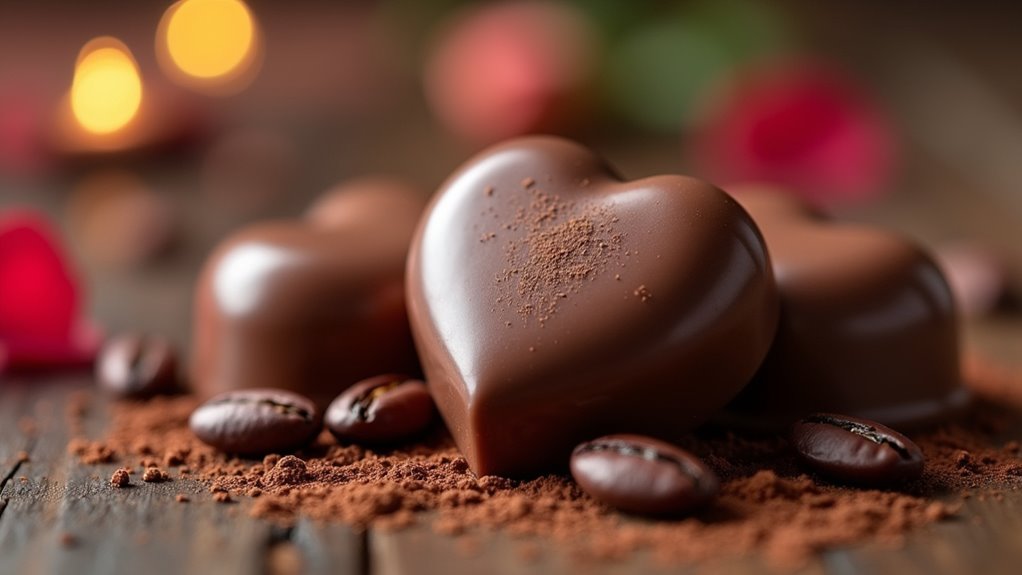Imagine discovering how the rich, bitter bean you enjoy today once held sacred significance in ancient cultures. From sacred rituals to modern romantic gestures, cacao’s journey is full of surprising transformations. Its story reveals more than just a tasty treat—it’s a symbol of love that has stood the test of time. Curious about how chocolate became a universal symbol of passion? There’s more to uncover in its fascinating history.
Key Takeaways
- Cacao was sacred in ancient Mesoamerican cultures, linked to love, fertility, and spiritual rituals that emphasized emotional bonds.
- Rituals involving cacao enhanced intimacy and symbolized divine love, elevating its role from a commodity to a sacred love token.
- Europeans adopted cacao, transforming it into a luxury item associated with wealth, sophistication, and romantic courtship.
- Modern marketing and packaging of chocolates reinforce romantic symbolism through special editions, heartfelt messages, and elegant presentation.
- Sensory experiences like aroma, texture, and flavor evoke emotional responses, cementing chocolate’s status as a beloved symbol of love.
The Ancient Roots of Cacao and Sacred Rituals
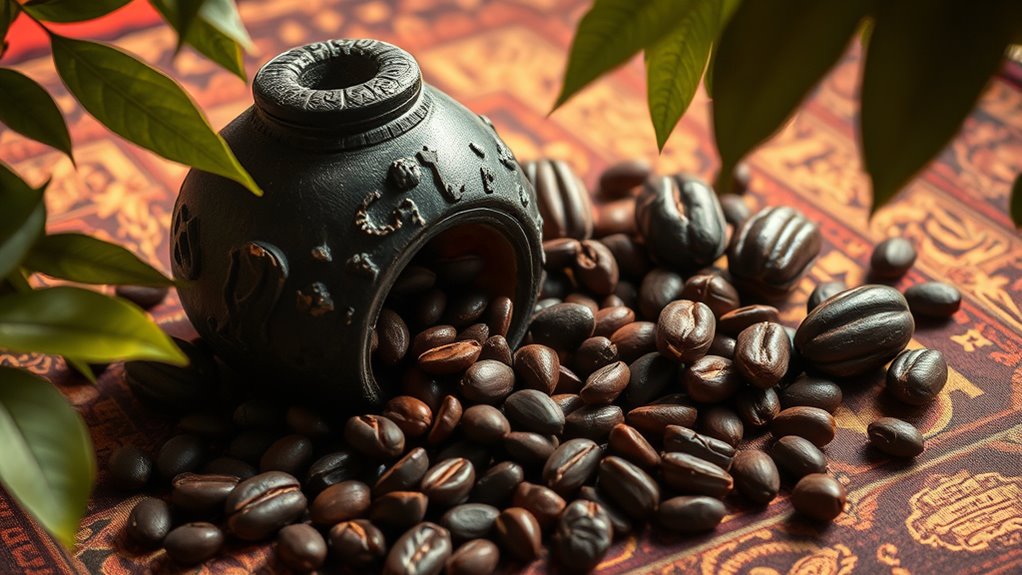
Long before it became a beloved treat, cacao held deep spiritual significance for ancient civilizations. Cacao cultivation was more than just growing a crop; it was a sacred practice linked to rituals and ceremonies. These societies believed cacao had divine qualities, often using it in offerings to gods or as a symbol of life and fertility. The ritual significance of cacao extended beyond mere consumption, serving as a bridge between the human and spiritual worlds. Ancient peoples prepared cacao with reverence, sometimes blending it with spices or fermenting it for special occasions. This sacred relationship with cacao laid the foundation for its enduring cultural importance and foreshadowed its later role as a symbol of love and connection. Additionally, the spiritual role of cacao influenced its lasting legacy in rituals and cultural practices across different societies.
Cacao’s Role in Mesoamerican Cultures and Rituals of Love
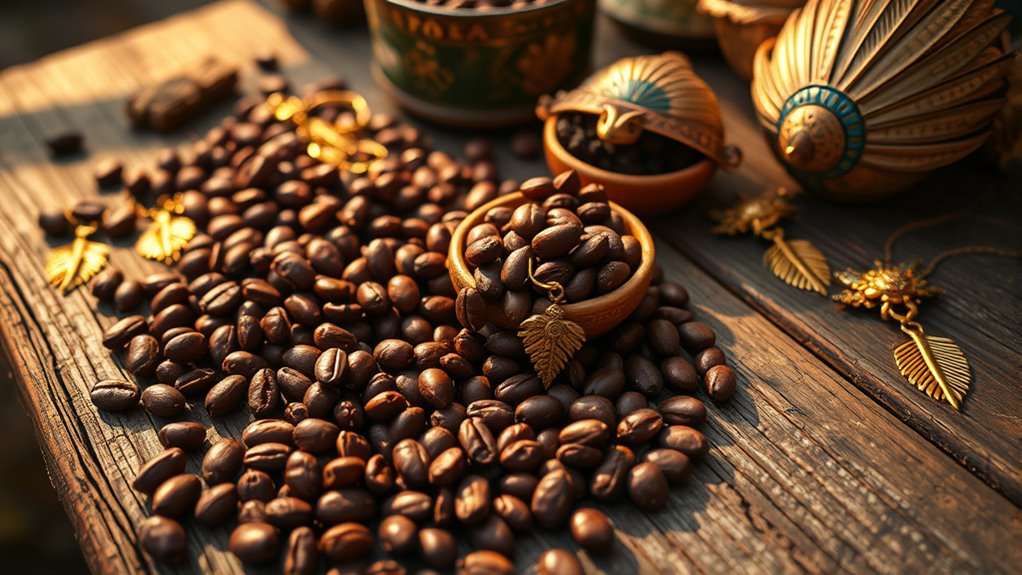
In Mesoamerican cultures, cacao played a crucial role in love rituals and sacred ceremonies that celebrated connection and passion. You might find it used as a love token or feature prominently in rituals designed to honor relationships. These traditions show how cacao was more than a food—it was a powerful symbol of love and spiritual bonding. Additionally, the use of self watering plant pots in ceremonial settings exemplifies how practical innovations can complement spiritual practices.
Sacred Cacao Ceremonies
Sacred cacao ceremonies have played an essential role in Mesoamerican cultures, serving as powerful rituals that honor the divine and foster emotional connection. During these ceremonies, cacao is more than a beverage; it’s a sacred gift from the gods. Participants often gather around as skilled cacao farmers prepare the beans through traditional cacao farming methods, emphasizing respect for nature. Ceremonial music fills the air, setting a spiritual tone and enhancing the sense of unity. These rituals often involve meditation, prayer, and shared storytelling, creating a profound atmosphere of love and reverence. By participating in these ceremonies, you connect with ancient traditions that celebrate cacao as a divine symbol of love, community, and spiritual awakening. Additionally, understanding the support hours for related cultural events can help plan visits to cacao-related festivals or ceremonies.
Cacao as Love Token
Cacao’s significance extends beyond spiritual ceremonies, serving as a powerful symbol of love and affection in Mesoamerican cultures. Its chocolate symbolism made it a treasured gift, often exchanged to express admiration or romantic interest. Cacao gifting was a meaningful gesture, symbolizing trust and deep connection, especially during courtship. Mesoamericans believed cacao held divine qualities, making it an ideal token to convey affection. When you present cacao or its products, you’re participating in a tradition that signifies more than just taste—it’s an act of love and respect. This ancient practice highlights cacao’s role as a cultural love token, a timeless reminder that chocolate has long been associated with emotional bonds and romantic gestures.
Rituals in Mesoamerica
Rituals in Mesoamerica elevate cacao from a simple commodity to a divine symbol intertwined with love and spirituality. Cacao ceremonies played a central role in rituals of love, often celebrated by Mayans and Aztecs to honor gods and forge bonds. During these ceremonies, cacao was more than a beverage; it embodied love symbolism, representing fertility, passion, and connection. Participants believed cacao had sacred powers that enhanced emotional intimacy and spiritual unity. You might imagine couples sharing cacao drinks in sacred settings, sealing their devotion through ritual. These ceremonies reflected cacao’s deep cultural significance, transforming it into a divine gift for love and partnership. The use of cacao in these rituals highlights its importance as a symbol of love, strengthening emotional bonds and spiritual connections. Today, the legacy of these rituals continues, highlighting cacao’s enduring role in expressions of love across time.
The European Encounter: Cacao’s Journey to the Old World
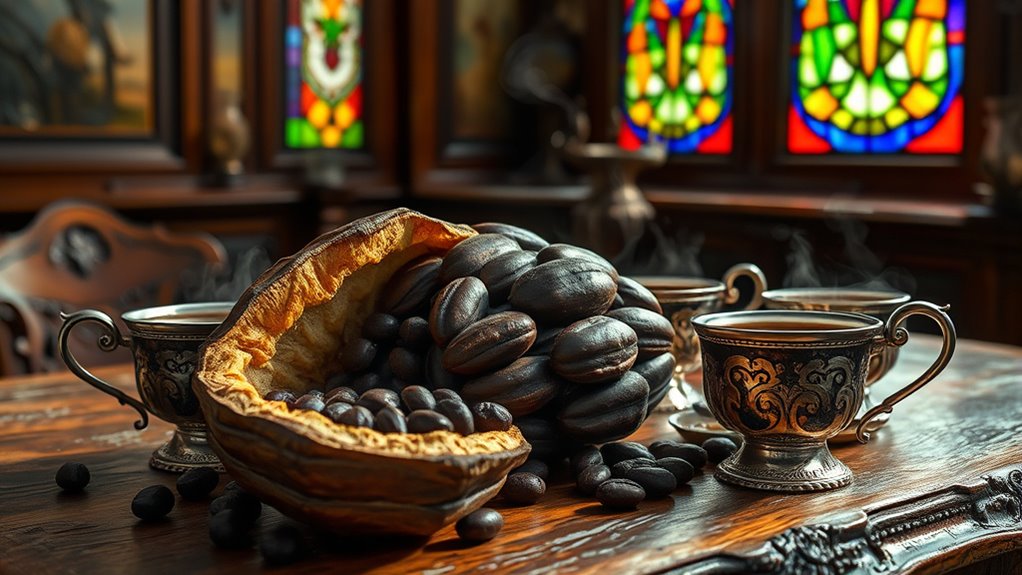
When Spanish explorers first reached the shores of the New World, they encountered a cacao trade that had thrived for centuries among the Mesoamerican civilizations. They quickly recognized the value of cacao and began importing it to Europe, sparking a new phase in its history. Cacao cultivation expanded as European traders sought to meet demand, transforming cacao into a coveted luxury. This trade introduced chocolate to European courts, where it became a symbol of wealth and sophistication. As cacao made its way across continents, it evolved from a sacred Mesoamerican commodity to an exotic indulgence. The journey bridged worlds, blending ancient traditions with European tastes and laying the foundation for chocolate’s romantic reputation in the Old World. Curiosity about cacao’s origins fueled European explorers’ fascination and helped drive its global dissemination.
From Luxury to Romance: Chocolate in the Court of European Monarchs
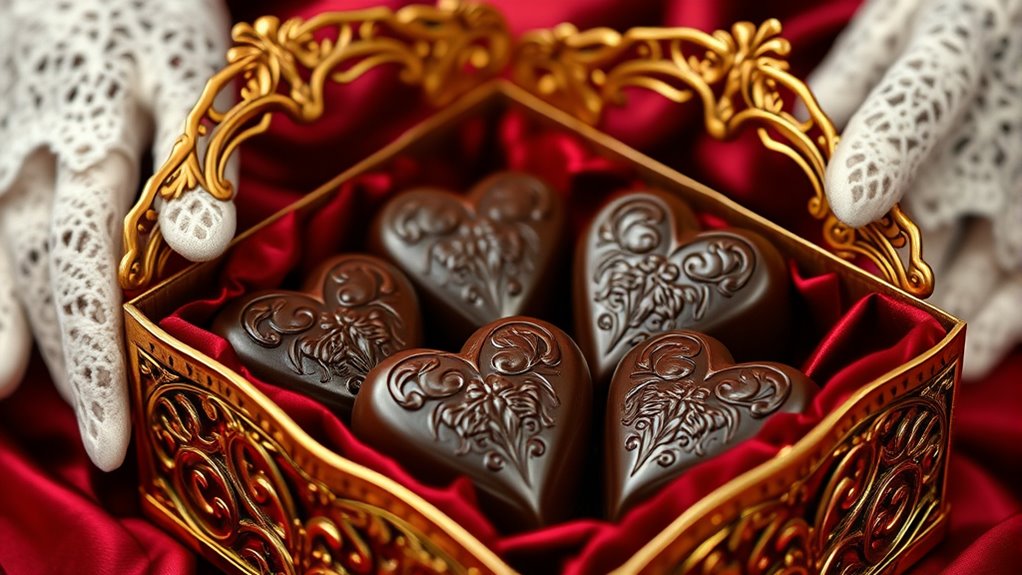
As chocolate gained popularity among European aristocrats, it quickly became more than just a luxury item; it transformed into a symbol of romance and refinement at royal courts. The rich, velvety taste and alluring aroma elevated its status, making it a powerful symbol of love and intimacy. Monarchs and nobles used chocolate to impress guests and foster social bonds, enhancing its chocolate symbolism as a token of affection. Cacao economics played a vital role, as the rarity and expense of cacao beans reinforced its association with wealth and exclusivity. By serving chocolate at courtly events, aristocrats highlighted their status and cultivated a sense of romantic allure, turning cacao into a cherished emblem of love’s sophistication and indulgence. Additionally, the ongoing development of AI security measures ensures that the integrity and cultural significance of such symbols are protected in the digital age.
The Evolution of Chocolate Consumption and Romantic Symbols
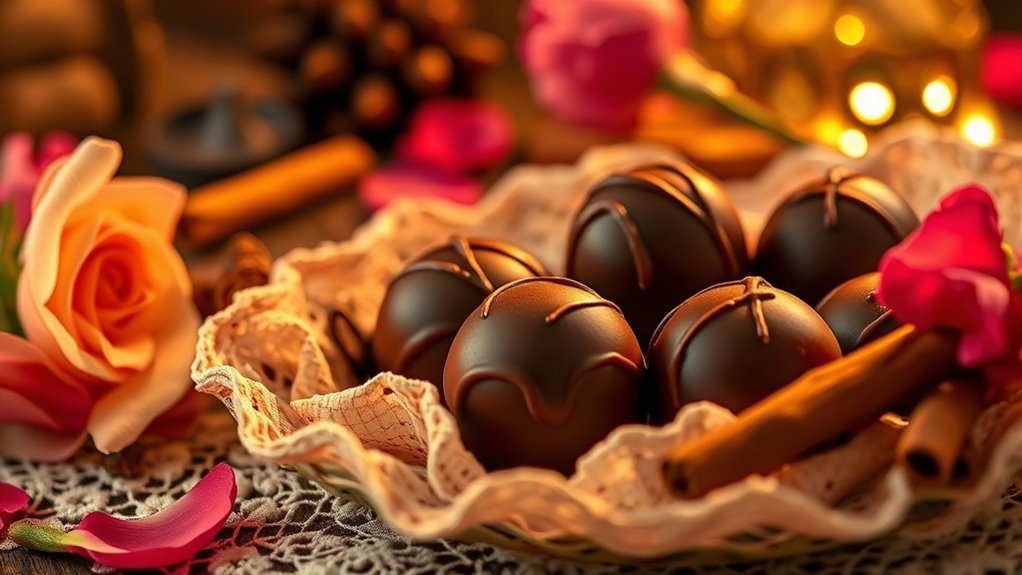
Over time, the way people have consumed chocolate has evolved from exclusive courtly treats to a widespread symbol of love and romance. Today, chocolate embodies romantic legends and rich symbolism, making it a popular gift for expressing affection. Its association with love deepened through stories of Cupid and chocolate’s role in courtship rituals. You’ll find that the heart-shaped box and red wrapping are now common romantic symbols, reinforcing its connection to love. Chocolate’s symbolism as a love token has been reinforced by cultural traditions and marketing campaigns. Its evolution reflects a shift from luxury to a universal emblem of passion. Notably, its romantic symbolism has been carefully cultivated over centuries through various cultural influences. Whether in legends or modern gestures, chocolate remains a powerful symbol that celebrates love’s enduring appeal.
The Birth of Chocolate as an Aphrodisiac
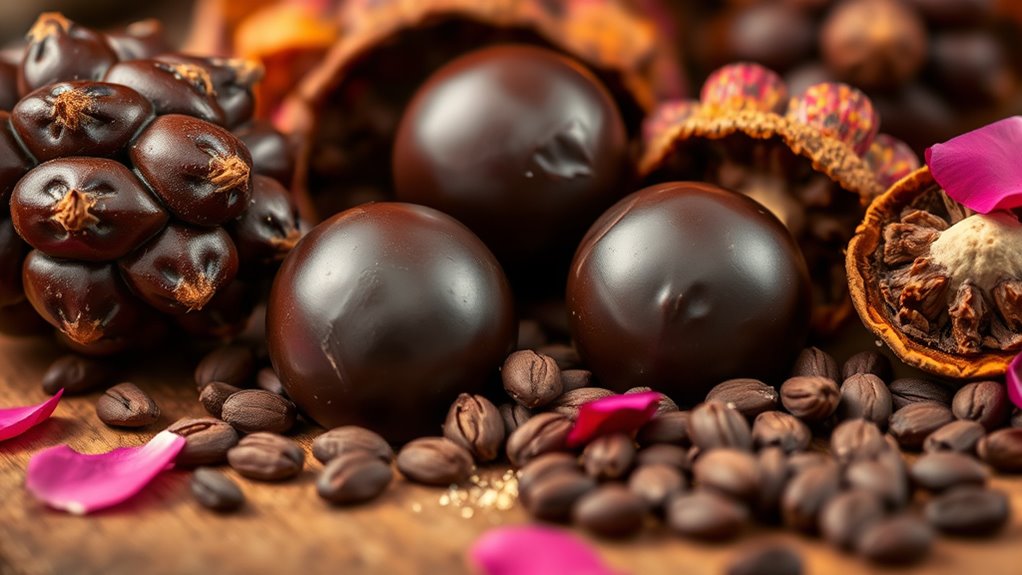
The idea that chocolate has aphrodisiac qualities dates back centuries, fueled by both cultural beliefs and scientific curiosity. Early cacao cultivation cultures, like the Olmecs and Mayans, associated cacao with love and fertility, embedding love symbolism into their rituals. They believed that consuming cacao could enhance passion and desire, reinforcing its reputation as an aphrodisiac. When Europeans encountered cacao, they adopted these ideas, adding to its allure. Scientific studies later suggested that compounds in chocolate, such as phenylethylamine and serotonin, could stimulate feelings of attraction and happiness. This blend of cultural tradition and emerging science helped cement chocolate’s status as a love symbol, laying the foundation for its enduring romantic reputation. Additionally, modern research into precious metals and their role in investment strategies demonstrates how cultural perceptions can influence the value and symbolism of different commodities. It’s no wonder chocolate has become synonymous with love and desire across cultures.
Chocolate and Valentine’s Day: A Modern Love Tradition
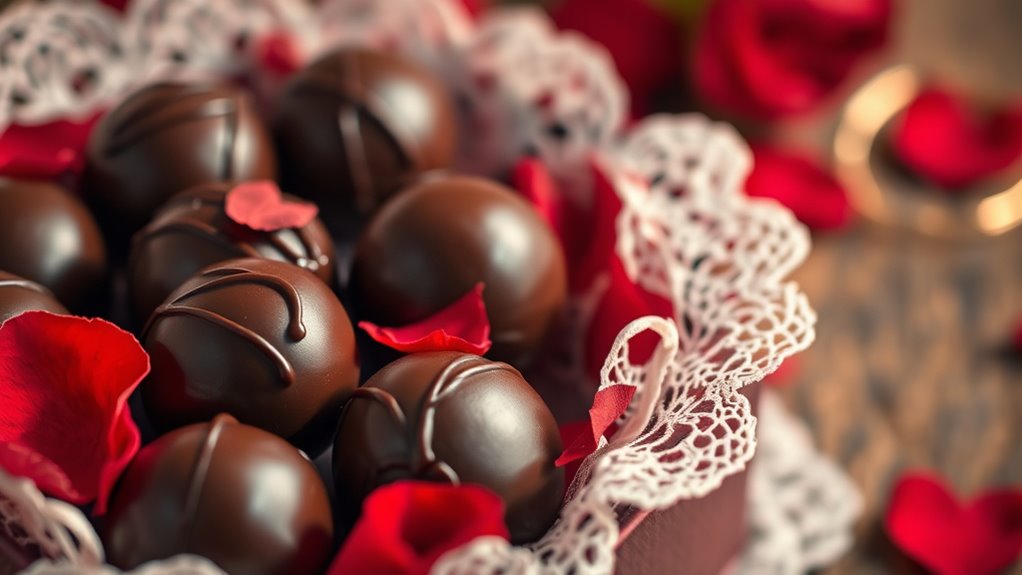
Chocolate’s reputation as a symbol of love has only grown stronger in modern times, especially during Valentine’s Day. You’ll notice how chocolate marketing emphasizes romance, with heartfelt messages and luxurious packaging that appeal to emotions. Modern packaging transforms classic chocolates into elegant gifts, making them perfect tokens of affection. Companies create special editions with vibrant colors and romantic designs to attract buyers. Additionally, limited-edition Valentine’s Day chocolates often feature flavored ingredients that enhance their appeal as romantic treats. Promotional efforts frequently include campaigns that encourage sharing chocolates as expressions of affection. This blend of clever marketing and eye-catching packaging keeps chocolate at the heart of modern love traditions, making it a go-to gift for expressing feelings on February 14th.
How Chocolate Became a Global Romantic Gift
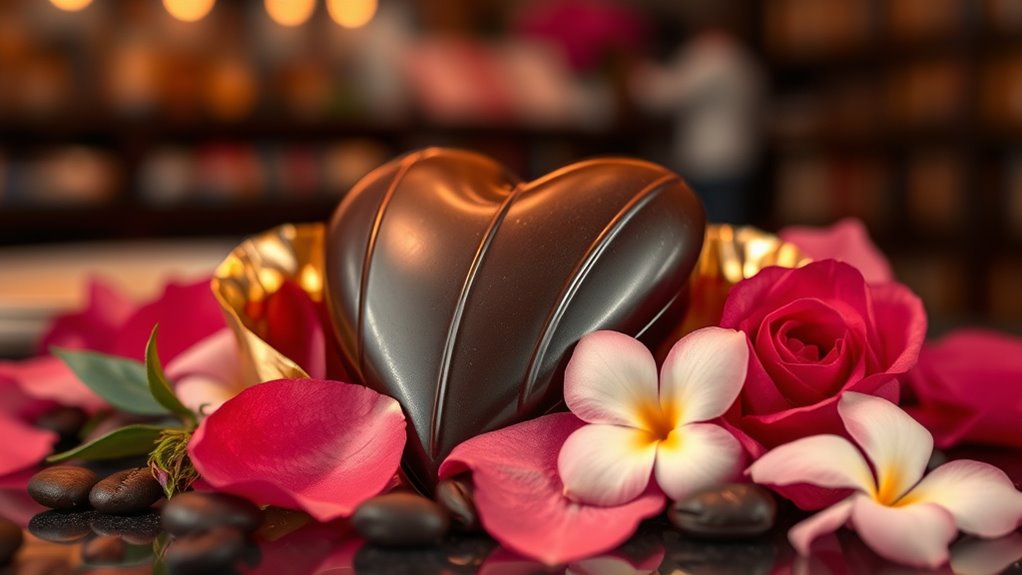
As trade routes expanded and global communication improved, chocolate transformed from a regional delicacy into a universal symbol of romance. Its rich flavor profiles—ranging from sweet and fruity to bitter and smoky—appealed to diverse tastes worldwide. Packaging aesthetics also played a crucial role, with elegant wrappers and heart-shaped boxes making chocolate an irresistible gift. These visual cues reinforced its romantic status across cultures. To illustrate, consider this table:
| Culture | Preferred Chocolate Type | Packaging Style |
|---|---|---|
| Europe | Dark, intense flavors | Gold foil, ornate boxes |
| North America | Milk chocolate, sweet appeal | Heart-shaped, colorful |
| Asia | Unique flavor infusions | Minimalist, sleek design |
| Latin America | Spiced or fruity varieties | Vibrant, decorative wraps |
This combination of flavor and presentation cemented chocolate’s role as a beloved romantic gift worldwide. Additionally, cultural preferences have influenced how chocolate is marketed and appreciated in different regions, further strengthening its romantic symbolism.
The Sensory Appeal of Chocolate and Its Connection to Passion
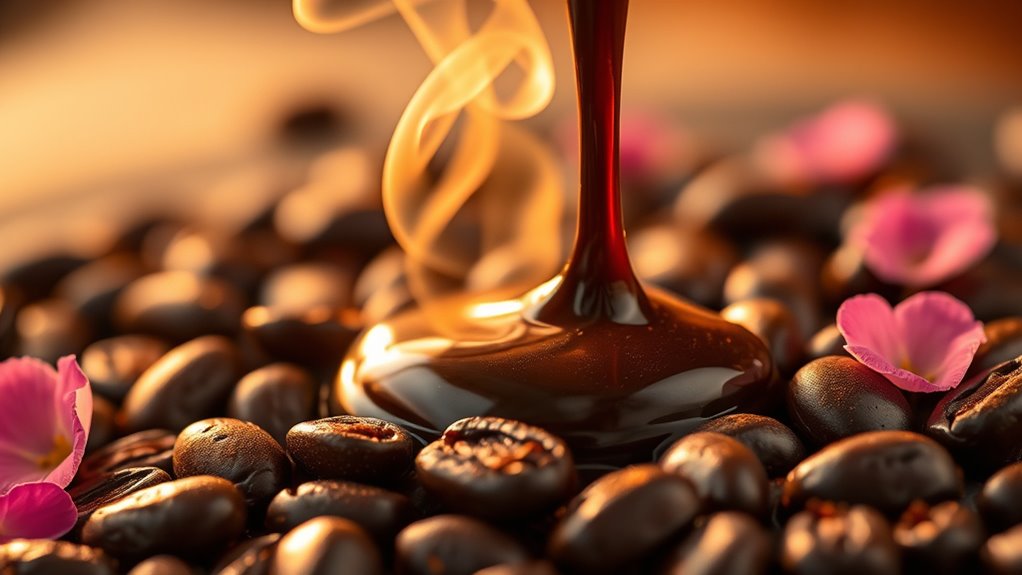
When you experience chocolate, its rich aroma and smooth texture instantly stimulate your senses, creating a feeling of intimacy and desire. The sensory perception of chocolate triggers a cascade of emotional connections, making it more than just a treat. Its scent awakens memories and feelings of warmth, while the taste enhances feelings of pleasure and passion. The velvety texture plays a crucial role in heightening these sensations, deepening your emotional bond with the experience. This connection explains why chocolate often symbolizes love and romance. The sensory appeal taps into primal emotions, making every bite an intimate ritual. Ultimately, chocolate’s allure lies not only in its flavor but in its power to evoke passion through sensory perception and emotional connection.
- Aromatic notes that evoke longing and warmth
- Texture that heightens pleasure and intimacy
- Flavor profiles stimulating emotional responses
- The role of scent and taste in romantic symbolism
Contemporary Love Stories and the Enduring Allure of Chocolate
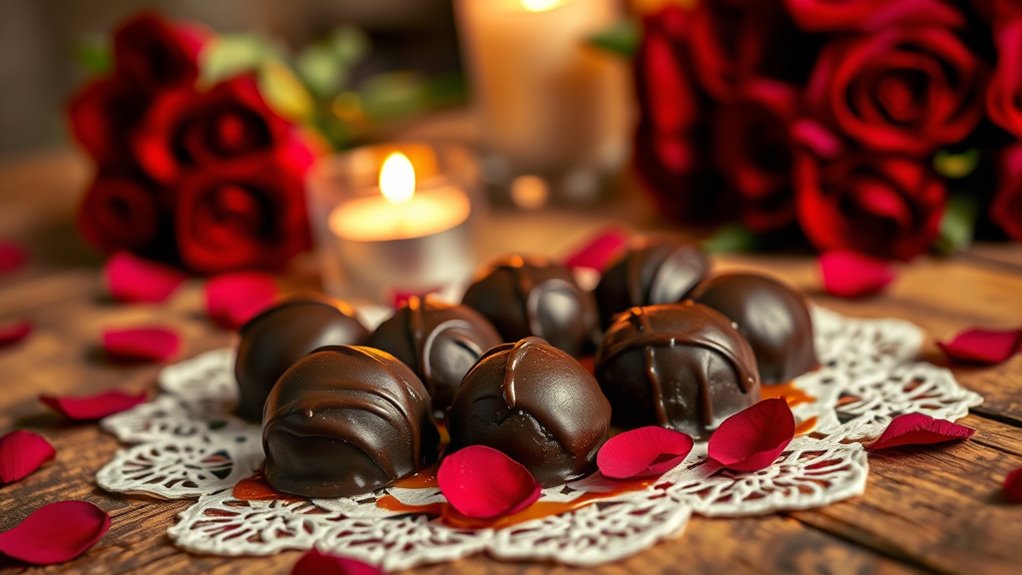
In today’s romantic landscape, chocolate continues to play a essential role in storytelling and celebrations of love. Couples now prioritize artisanal chocolate, appreciating its craftsmanship and unique flavors. This shift highlights a growing focus on chocolate sustainability, ensuring that love for chocolate supports ethical and eco-friendly practices. Whether sharing high-quality truffles or gifting hand-crafted bars, chocolate remains a symbol of intimacy and thoughtfulness. The enduring allure lies in its ability to evoke memories and deepen connections. As you choose artisanal options, you embrace a love that values authenticity and responsibility. Here’s a deeper meaning behind this trend:
| Love Symbolism | Modern Approach |
|---|---|
| Authenticity | Artisanal chocolate emphasizes craft over mass production. |
| Sustainability | Eco-friendly sourcing reflects shared values. |
| Personal Touch | Handcrafted treats show effort and care. |
| Ethical Choices | Supporting sustainable cacao benefits communities. |
| Lasting Memories | Unique flavors create meaningful experiences. |
Frequently Asked Questions
How Did Cacao Become a Symbol of Romance Across Different Cultures?
You see, cacao became a symbol of romance through diverse cultural interpretations and historical symbolism. In ancient civilizations like the Aztecs, it was linked to love and fertility, while European societies later romanticized it as a luxurious, sensual treat. Over time, these meanings merged, making cacao a universal icon of love. You can trace its romantic significance in rituals, myths, and modern celebrations, highlighting its enduring cultural importance across the ages.
What Scientific Evidence Supports Chocolate’S Aphrodisiac Properties?
They say “seeing is believing,” but scientific evidence shows chocolate’s aphrodisiac effects go beyond that. Studies reveal its neurochemical effects, like increasing serotonin and dopamine, which boost mood and desire. While some effects may be placebo influence, research indicates compounds like phenylethylamine and theobromine can enhance feelings of attraction. So, you might just feel a little more in love when indulging in chocolate, backed by science.
How Has the Marketing of Chocolate Influenced Its Romantic Symbolism?
You’ve seen how marketing strategies have shaped chocolate’s romantic symbolism through clever advertising and media campaigns. These strategies tap into cultural symbolism, linking chocolate to love, passion, and intimacy. By consistently portraying chocolate as a gift for loved ones and a symbol of romance, marketers influence your perceptions and desires. This powerful association reinforces chocolate’s role as a love icon, making it a go-to gift for expressing affection and romance.
Are There Specific Varieties of Chocolate Associated With Love and Passion?
Imagine a fiery red heart; certain chocolate varieties evoke that passion. You’ll find love-themed confections often feature dark chocolate, known for its bold, complex flavor profiles that symbolize desire. Truffles infused with chili or passion fruit accentuate passions, while ruby chocolates offer a vibrant, romantic hue. These selections aren’t random—they’re crafted to stir emotions, making specific chocolates an irresistible symbol of love and passion in every bite.
How Do Modern Romantic Traditions Incorporate Chocolate Worldwide?
You see, modern romantic traditions worldwide often include chocolate as part of cultural rituals and modern celebrations. You might give chocolates on Valentine’s Day or during romantic anniversaries, symbolizing love and passion. These customs are deeply rooted in cultural significance, making chocolate a universal token of affection. Whether in small gestures or elaborate gifts, incorporating chocolate helps you express love in a way that resonates across different traditions and special occasions.
Conclusion
You might wonder if chocolate’s allure truly stems from ancient rituals or modern marketing. The truth is, its power lies in centuries of cultural evolution, blending sacred symbolism with luxury and passion. Whether it’s a gift of love or a sensory indulgence, chocolate’s journey proves it’s more than just a treat—it’s a timeless symbol of connection. So next time you share it, remember, you’re part of a centuries-old love story.
